Oegopsida
Richard E. Young and Michael Vecchione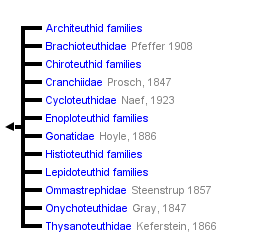


This tree diagram shows the relationships between several groups of organisms.
The root of the current tree connects the organisms featured in this tree to their containing group and the rest of the Tree of Life. The basal branching point in the tree represents the ancestor of the other groups in the tree. This ancestor diversified over time into several descendent subgroups, which are represented as internal nodes and terminal taxa to the right.

You can click on the root to travel down the Tree of Life all the way to the root of all Life, and you can click on the names of descendent subgroups to travel up the Tree of Life all the way to individual species.
For more information on ToL tree formatting, please see Interpreting the Tree or Classification. To learn more about phylogenetic trees, please visit our Phylogenetic Biology pages.
close boxIntroduction
Among cephalopods, oegopsid squids dominate the pelagic, oceanic environment. Diversity at the family and generic levels is very high with 24 families and 69 genera. Although pelagic, some species are consistently associated with and some occasionally sit on the ocean floor.
Diagnosis
Decapodiforms ...
- without cornea covering eyes.
- with a gladius.
Characteristics
- Arms
- Suckers without circularis muscles.
- Tentacles
- Tentacular club usually with carpal (= proximal) locking-apparatus.
- Suckers without circularis muscles (see Sepioidea page).
- Buccal crown
- Buccal supports lack suckers.
- Head
- Head without tentacle pockets.
- Eyes without corneal membranes covering lenses.
- Funnel
- Funnel without lateral adductor muscles. [The more superficial lateral-adductor muscles of sepioids should not to be confused with the external-adductor muscles of the Ommastrephidae.]
- Mantle
- Mantle locking-apparatus, with rare exceptions, reaches anterior mantle margin.
- Fins
- Fins usually joined posteriorly and usually without posterior lobes.
- Shell
- Shell a gladius.
- Viscera
- Gills with branchial canal.
- Oviducts paired.
- Females without accessory nidamental glands.
- Eggs
- Eggs, where known, in pelagic egg masses or egg strings.

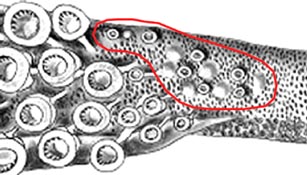
Figure. Oral view of the club base of Cycloteuthis serventyi. The red line encircles the suckers and knobs of the carpal locking-apparatus. Drawing modified from Young and Roper (1969).
Comments
Comparisons of the major groups of the Oegopsida| CHARACTER TAXA | Buccal connective attachment to arms IV | Funnel-mantle lock; reaches anterior mantle margin | Carpal locking-apparatus present | Gladius conus type |
| Architeuthid families | Dorsal | Straight; yes | Yes | Primary |
| Brachioteuthidae | Ventral | Straight; yes | Yes/No | Secondary |
| Chiroteuthid families | Ventral | Variable, usually oval, often with knobs; yes?? | No | Secondary |
| Cranchiidae | Ventral | Fused; yes | Yes | Secondary/ pseudoconus/ no conus |
| Cycloteuthidae | Ventral | Triangular; no | Yes | Secondary/no conus |
| Enoploteuthid families | Dorsal | Straight; yes | Yes | Primary |
| Gonatidae | Ventral | Straight; yes | Yes | Primary |
| Histioteuthidae families | Dorsal | Straight; yes | Yes | No conus; cupped coil |
| Lepidoteuthidae families | Ventral | Straight; yes | NA/No | Secondary |
| Ommastrephidae | Dorsal | Inverted-T; yes | Yes/No | Primary |
| Onychoteuthidae | Ventral | Straight; yes | Yes | Primary |
| Thysanoteuthidae | Ventral | Lazy-T; yes | Yes | Primary in very young only; no conus |
Title Illustrations

| Scientific Name | Pyroteuthis margaritifera, Promachoteuthis sp., Magnapinna ?, Helicocranchia pfefferi, Joubiniteuthis portieri, Onychoteuthis sp., Todarodes sagittatus |
|---|---|
| Acknowledgements | J. portieri photograph by Frank Parish; Magnapinna (?) photograph from N.U.R.C., others photographed by R. Young. |
| Image Use |
 This media file is licensed under the Creative Commons Attribution-NonCommercial License - Version 3.0. This media file is licensed under the Creative Commons Attribution-NonCommercial License - Version 3.0.
|
| Copyright |
© 2004

|
About This Page

University of Hawaii, Honolulu, HI, USA

National Museum of Natural History, Washington, D. C. , USA
Page copyright © 2019 and
 Page: Tree of Life
Oegopsida .
Authored by
Richard E. Young and Michael Vecchione.
The TEXT of this page is licensed under the
Creative Commons Attribution-NonCommercial License - Version 3.0. Note that images and other media
featured on this page are each governed by their own license, and they may or may not be available
for reuse. Click on an image or a media link to access the media data window, which provides the
relevant licensing information. For the general terms and conditions of ToL material reuse and
redistribution, please see the Tree of Life Copyright
Policies.
Page: Tree of Life
Oegopsida .
Authored by
Richard E. Young and Michael Vecchione.
The TEXT of this page is licensed under the
Creative Commons Attribution-NonCommercial License - Version 3.0. Note that images and other media
featured on this page are each governed by their own license, and they may or may not be available
for reuse. Click on an image or a media link to access the media data window, which provides the
relevant licensing information. For the general terms and conditions of ToL material reuse and
redistribution, please see the Tree of Life Copyright
Policies.
- First online 18 August 2004
- Content changed 26 March 2019
Citing this page:
Young, Richard E. and Michael Vecchione. 2019. Oegopsida . Version 26 March 2019 (under construction). http://tolweb.org/Oegopsida/19407/2019.03.26 in The Tree of Life Web Project, http://tolweb.org/




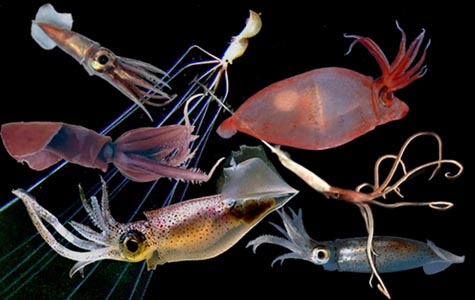
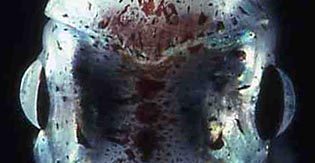

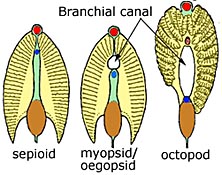


 Go to quick links
Go to quick search
Go to navigation for this section of the ToL site
Go to detailed links for the ToL site
Go to quick links
Go to quick search
Go to navigation for this section of the ToL site
Go to detailed links for the ToL site